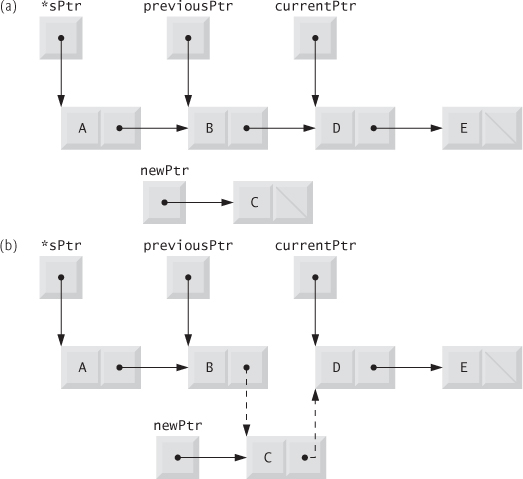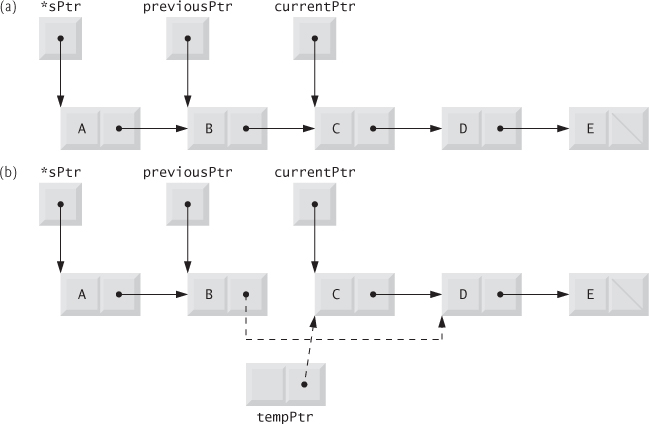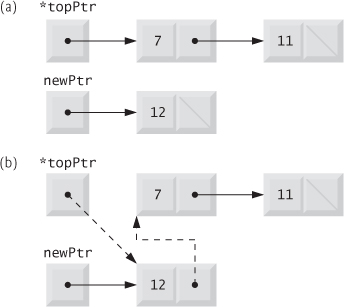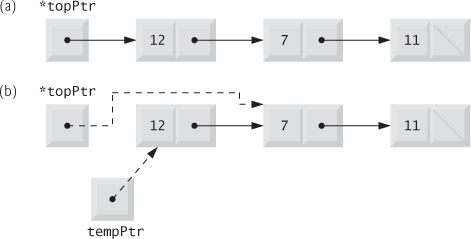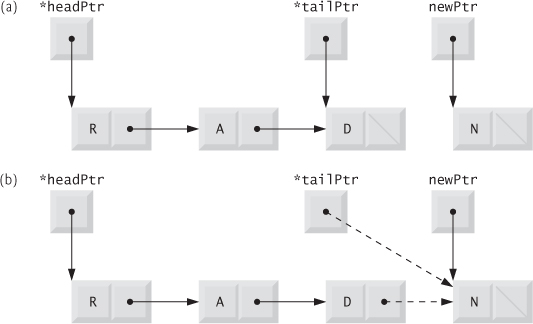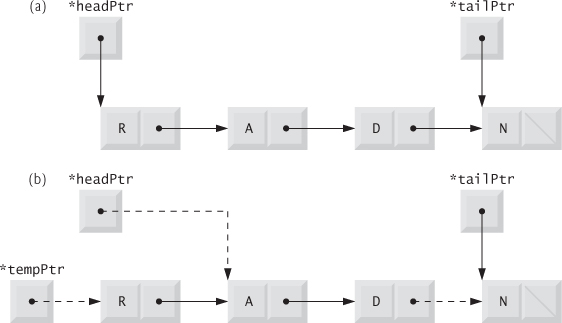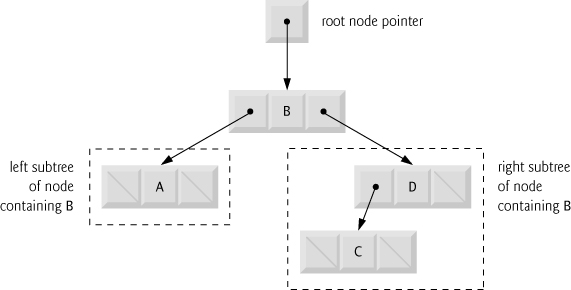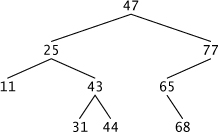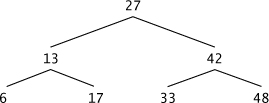12. Data Structures
Objectives
In this chapter you’ll:
![]() Allocate and free memory dynamically for data objects.
Allocate and free memory dynamically for data objects.
![]() Form linked data structures using pointers, self-referential structures and recursion.
Form linked data structures using pointers, self-referential structures and recursion.
![]() Create and manipulate linked lists, queues, stacks and binary trees.
Create and manipulate linked lists, queues, stacks and binary trees.
![]() Learn important applications of linked data structures.
Learn important applications of linked data structures.
Outline
12.2 Self-Referential Structures
12.3 Dynamic Memory Allocation
12.7.2 Traversals: Functions inOrder, preOrder and postOrder
12.1. Introduction
We’ve studied fixed-size data structures such as single-subscripted arrays, double-subscripted arrays and structs. This chapter introduces dynamic data structures that can grow and shrink at execution time.
• Linked lists are collections of data items “lined up in a row”—insertions and deletions are made anywhere in a linked list.
• Stacks are important in compilers and operating systems—insertions and deletions are made only at one end of a stack—its top.
• Queues represent waiting lines; insertions are made only at the back (also referred to as the tail) of a queue and deletions are made only from the front (also referred to as the head) of a queue.
• Binary trees facilitate high-speed searching and sorting of data, efficient elimination of duplicate data items, representing file-system directories and compiling expressions into machine language.
Each of these data structures has many other interesting applications.
We’ll discuss each of the major types of data structures and implement programs that create and manipulate them.
12.2. Self-Referential Structures
Recall that a self-referential structure contains a pointer member that points to a structure of the same structure type. For example, the definition
struct node {
int data;
struct node *nextPtr;
}; // end struct node
defines a type, struct node. A structure of type struct node has two members—integer member data and pointer member nextPtr. Member nextPtr points to a structure of type struct node—a structure of the same type as the one being declared here, hence the term self-referential structure. Member nextPtr is referred to as a link—i.e., it can be used to “tie” a structure of type struct node to another structure of the same type. Self-referential structures can be linked together to form useful data structures such as lists, queues, stacks and trees. Figure 12.1 illustrates two self-referential structure objects linked together to form a list. A slash—representing a NULL pointer—is placed in the link member of the second self-referential structure to indicate that the link does not point to another structure. [Note: The slash is only for illustration purposes; it does not correspond to the backslash character in C.] A NULL pointer normally indicates the end of a data structure just as the null character indicates the end of a string.
 Common Programming Error 12.1
Common Programming Error 12.1
Not setting the link in the last node of a list to NULL can lead to runtime errors.
12.3. Dynamic Memory Allocation
Creating and maintaining dynamic data structures requires dynamic memory allocation—the ability for a program to obtain more memory space at execution time to hold new nodes, and to release space no longer needed.
Functions malloc and free, and operator sizeof, are essential to dynamic memory allocation. Function malloc takes as an argument the number of bytes to be allocated and returns a pointer of type void * (pointer to void) to the allocated memory. As you recall, a void * pointer may be assigned to a variable of any pointer type. Function malloc is normally used with the sizeof operator. For example, the statement
newPtr = malloc( sizeof( struct node ) );
evaluates sizeof(struct node) to determine the size in bytes of a structure of type struct node, allocates a new area in memory of that number of bytes and stores a pointer to the allocated memory in variable newPtr. The allocated memory is not initialized. If no memory is available, malloc returns NULL.
Function free deallocates memory—i.e., the memory is returned to the system so that it can be reallocated in the future. To free memory dynamically allocated by the preceding malloc call, use the statement
free( newPtr );
C also provides functions calloc and realloc for creating and modifying dynamic arrays. These functions are discussed in Section 14.9. The sections that follow discuss lists, stacks, queues and trees, each of which is created and maintained with dynamic memory allocation and self-referential structures.
 Portability Tip 12.1
Portability Tip 12.1
A structure’s size is not necessarily the sum of the sizes of its members. This is so because of various machine-dependent boundary alignment requirements (see Chapter 10).
 Error-Prevention Tip 12.1
Error-Prevention Tip 12.1
When using malloc, test for a NULL pointer return value, which indicates that the memory was not allocated.
 Common Programming Error 12.2
Common Programming Error 12.2
Not returning dynamically allocated memory when it’s no longer needed can cause the system to run out of memory prematurely. This is sometimes called a “memory leak.”
 Error-Prevention Tip 12.2
Error-Prevention Tip 12.2
When memory that was dynamically allocated is no longer needed, use free to return the memory to the system immediately. Then set the pointer to NULL to eliminate the possibility that the program could refer to memory that’s been reclaimed and which may have already been allocated for another purpose.
 Common Programming Error 12.3
Common Programming Error 12.3
Freeing memory not allocated dynamically with malloc is an error.
 Common Programming Error 12.4
Common Programming Error 12.4
Referring to memory that has been freed is an error that typically results in the program crashing.
12.4. Linked Lists
A linked list is a linear collection of self-referential structures, called nodes, connected by pointer links—hence, the term “linked” list. A linked list is accessed via a pointer to the first node of the list. Subsequent nodes are accessed via the link pointer member stored in each node. By convention, the link pointer in the last node of a list is set to NULL to mark the end of the list. Data is stored in a linked list dynamically—each node is created as necessary. A node can contain data of any type including other structs. Stacks and queues are also linear data structures, and, as we’ll see, are constrained versions of linked lists. Trees are nonlinear data structures.
Lists of data can be stored in arrays, but linked lists provide several advantages. A linked list is appropriate when the number of data elements to be represented in the data structure is unpredictable. Linked lists are dynamic, so the length of a list can increase or decrease at execution time as necessary. The size of an array created at compile time, however, cannot be altered. Arrays can become full. Linked lists become full only when the system has insufficient memory to satisfy dynamic storage allocation requests.
 Performance Tip 12.1
Performance Tip 12.1
An array can be declared to contain more elements than the number of data items expected, but this can waste memory. Linked lists can provide better memory utilization in these situations.
Linked lists can be maintained in sorted order by inserting each new element at the proper point in the list.
 Performance Tip 12.2
Performance Tip 12.2
Insertion and deletion in a sorted array can be time consuming—all the elements following the inserted or deleted element must be shifted appropriately.
 Performance Tip 12.3
Performance Tip 12.3
The elements of an array are stored contiguously in memory. This allows immediate access to any array element because the address of any element can be calculated directly based on its position relative to the beginning of the array. Linked lists do not afford such immediate access to their elements.
Linked-list nodes are normally not stored contiguously in memory. Logically, however, the nodes of a linked list appear to be contiguous. Figure 12.2 illustrates a linked list with several nodes.
 Performance Tip 12.4
Performance Tip 12.4
Using dynamic memory allocation (instead of arrays) for data structures that grow and shrink at execution time can save memory. Keep in mind, however, that the pointers take up space, and that dynamic memory allocation incurs the overhead of function calls.
Figure 12.3 (output shown in Fig. 12.4) manipulates a list of characters. You can insert a character in the list in alphabetical order (function insert) or delete a character from the list (function delete). A detailed discussion of the program follows.
1 // Fig. 12.3: fig12_03.c
2 // Inserting and deleting nodes in a list
3 #include <stdio.h>
4 #include <stdlib.h>
5
6 // self-referential structure
7 struct listNode {
8 char data; // each listNode contains a character
9 struct listNode *nextPtr; // pointer to next node
10 }; // end structure listNode
11
12 typedef struct listNode ListNode; // synonym for struct listNode
13 typedef ListNode *ListNodePtr; // synonym for ListNode*
14
15 // prototypes
16 void insert( ListNodePtr *sPtr, char value );
17 char delete( ListNodePtr *sPtr, char value );
18 int isEmpty( ListNodePtr sPtr );
19 void printList( ListNodePtr currentPtr );
20 void instructions( void );
21
22 int main( void )
23 {
24 ListNodePtr startPtr = NULL; // initially there are no nodes
25 unsigned int choice; // user's choice
26 char item; // char entered by user
27
28 instructions(); // display the menu
29 printf( "%s", "? " );
30 scanf( "%u", &choice );
31
32 // loop while user does not choose 3
33 while ( choice != 3 ) {
34
35 switch ( choice ) {
36 case 1:
37 printf( "%s", "Enter a character: " );
38 scanf( "
%c", &item );
39 insert( &startPtr, item ); // insert item in list
40 printList( startPtr );
41 break;
42 case 2: // delete an element
43 // if list is not empty
44 if ( !isEmpty( startPtr ) ) {
45 printf( "%s", "Enter character to be deleted: " );
46 scanf( "
%c", &item );
47
48 // if character is found, remove it
49 if ( delete( &startPtr, item ) ) { // remove item
50 printf( "%c deleted.
", item );
51 printList( startPtr );
52 } // end if
53 else {
54 printf( "%c not found.
", item );
55 } // end else
56 } // end if
57 else {
58 puts( "List is empty.
" );
59 } // end else
60
61 break;
62 default:
63 puts( "Invalid choice.
" );
64 instructions();
65 break;
66 } // end switch
67
68 printf( "%s", "? " );
69 scanf( "%u", &choice );
70 } // end while
71
72 puts( "End of run." );
73 } // end main
74
75 // display program instructions to user
76 void instructions( void )
77 {
78 puts( "Enter your choice:
"
79 " 1 to insert an element into the list.
"
80 " 2 to delete an element from the list.
"
81 " 3 to end." );
82 } // end function instructions
83
84 // insert a new value into the list in sorted order
85 void insert( ListNodePtr *sPtr, char value )
86 {
87 ListNodePtr newPtr; // pointer to new node
88 ListNodePtr previousPtr; // pointer to previous node in list
89 ListNodePtr currentPtr; // pointer to current node in list
90
91 newPtr = malloc( sizeof( ListNode ) ); // create node
92
93 if ( newPtr != NULL ) { // is space available
94 newPtr->data = value; // place value in node
95 newPtr->nextPtr = NULL; // node does not link to another node
96
97 previousPtr = NULL;
98 currentPtr = *sPtr;
99
100 // loop to find the correct location in the list
101 while ( currentPtr != NULL && value > currentPtr->data ) {
102 previousPtr = currentPtr; // walk to ...
103 currentPtr = currentPtr->nextPtr; // ... next node
104 } // end while
105
106 // insert new node at beginning of list
107 if ( previousPtr == NULL ) {
108 newPtr->nextPtr = *sPtr;
109 *sPtr = newPtr;
110 } // end if
111 else { // insert new node between previousPtr and currentPtr
112 previousPtr->nextPtr = newPtr;
113 newPtr->nextPtr = currentPtr;
114 } // end else
115 } // end if
116 else {
117 printf( "%c not inserted. No memory available.
", value );
118 } // end else
119 } // end function insert
120
121 // delete a list element
122 char delete( ListNodePtr *sPtr, char value )
123 {
124 ListNodePtr previousPtr; // pointer to previous node in list
125 ListNodePtr currentPtr; // pointer to current node in list
126 ListNodePtr tempPtr; // temporary node pointer
127
128 // delete first node
129 if ( value == ( *sPtr )->data ) {
130 tempPtr = *sPtr; // hold onto node being removed
131 *sPtr = ( *sPtr )->nextPtr; // de-thread the node
132 free( tempPtr ); // free the de-threaded node
133 return value;
134 } // end if
135 else {
136 previousPtr = *sPtr;
137 currentPtr = ( *sPtr )->nextPtr;
138
139 // loop to find the correct location in the list
140 while ( currentPtr != NULL && currentPtr->data != value ) {
141 previousPtr = currentPtr; // walk to ...
142 currentPtr = currentPtr->nextPtr; // ... next node
143 } // end while
144
145 // delete node at currentPtr
146 if ( currentPtr != NULL ) {
147 tempPtr = currentPtr;
148 previousPtr->nextPtr = currentPtr->nextPtr;
149 free( tempPtr );
150 return value;
151 } // end if
152 } // end else
153
154 return '�';
155 } // end function delete
156
157 // return 1 if the list is empty, 0 otherwise
158 int isEmpty( ListNodePtr sPtr )
159 {
160 return sPtr == NULL;
161 } // end function isEmpty
162
163 // print the list
164 void printList( ListNodePtr currentPtr )
165 {
166 // if list is empty
167 if ( isEmpty( currentPtr ) ) {
168 puts( "List is empty.
" );
169 } // end if
170 else {
171 puts( "The list is:" );
172
173 // while not the end of the list
174 while ( currentPtr != NULL ) {
175 printf( "%c --> ", currentPtr->data );
176 currentPtr = currentPtr->nextPtr;
177 } // end while
178
179 puts( "NULL
" );
180 } // end else
181 } // end function printList
Fig. 12.3 Inserting and deleting nodes in a list.
Enter your choice:
1 to insert an element into the list.
2 to delete an element from the list.
3 to end.
? 1
Enter a character: B
The list is:
B --> NULL
? 1
Enter a character: A
The list is:
A --> B --> NULL
? 1
Enter a character: C
The list is:
A --> B --> C --> NULL
? 2
Enter character to be deleted: D
D not found.
? 2
Enter character to be deleted: B
B deleted.
The list is:
A --> C --> NULL
? 2
Enter character to be deleted: C
C deleted.
The list is:
A --> NULL
? 2
Enter character to be deleted: A
A deleted.
List is empty.
? 4
Invalid choice.
Enter your choice:
1 to insert an element into the list.
2 to delete an element from the list.
3 to end.
? 3
End of run.
Fig. 12.4 Sample output for the program of Fig. 12.3.
The primary functions of linked lists are insert (lines 85–119) and delete (lines 122–155). Function isEmpty (lines 158–161) is called a predicate function—it does not alter the list in any way; rather it determines whether the list is empty (i.e., the pointer to the first node of the list is NULL). If the list is empty, 1 is returned; otherwise, 0 is returned. [Note: If you’re using a compiler that’s compliant with the C standard, you can use the _Bool type (Section 4.10) rather than int.] Function printList (lines 164–181) prints the list.
12.4.1. Function insert
Characters are inserted in the list in alphabetical order. Function insert (lines 85–119) receives the address of the list and a character to be inserted. The list’s address is necessary when a value is to be inserted at the start of the list. Providing the address enables the list (i.e., the pointer to the first node of the list) to be modified via a call by reference. Because the list itself is a pointer (to its first element), passing its address creates a pointer to a pointer (i.e., double indirection). This is a complex notion and requires careful programming. The steps for inserting a character in the list are as follows:
1. Create a node by calling malloc, assigning to newPtr the address of the allocated memory (line 91), assigning the character to be inserted to newPtr->data (line 94), and assigning NULL to newPtr->nextPtr (line 95).
2. Initialize previousPtr to NULL (line 97) and currentPtr to *sPtr (line 98)—the pointer to the start of the list. Pointers previousPtr and currentPtr store the locations of the node preceding the insertion point and the node after the insertion point.
3. While currentPtr is not NULL and the value to be inserted is greater than currentPtr->data (line 101), assign currentPtr to previousPtr (line 102) and advance currentPtr to the next node in the list (line 103). This locates the insertion point for the value.
4. If previousPtr is NULL (line 107), insert the new node as the first node in the list (lines 108–109). Assign *sPtr to newPtr->nextPtr (the new node link points to the former first node) and assign newPtr to *sPtr (*sPtr points to the new node). Otherwise, if previousPtr is not NULL, the new node is inserted in place (lines 112–113). Assign newPtr to previousPtr->nextPtr (the previous node points to the new node) and assign currentPtr to newPtr->nextPtr (the new node link points to the current node).
 Error-Prevention Tip 12.3
Error-Prevention Tip 12.3
Assign NULL to the link member of a new node. Pointers should be initialized before they’re used.
Figure 12.5 illustrates the insertion of a node containing the character 'C' into an ordered list. Part (a) of the figure shows the list and the new node just before the insertion. Part (b) of the figure shows the result of inserting the new node. The reassigned pointers are dotted arrows. For simplicity, we implemented function insert (and other similar functions in this chapter) with a void return type. It’s possible that function malloc will fail to allocate the requested memory. In this case, it would be better for our insert function to return a status that indicates whether the operation was successful.
12.4.2. Function delete
Function delete (Fig. 12.3, lines 122–155) receives the address of the pointer to the start of the list and a character to be deleted. The steps for deleting a character from the list are as follows (see Fig. 12.6):
1. If the character to be deleted matches the character in the first node of the list (line 129), assign *sPtr to tempPtr (tempPtr will be used to free the unneeded memory), assign (*sPtr)->nextPtr to *sPtr (*sPtr now points to the second node in the list), free the memory pointed to by tempPtr, and return the character that was deleted.
2. Otherwise, initialize previousPtr with *sPtr and initialize currentPtr with (*sPtr)->nextPtr (lines 136–137) to advance to the second node.
3. While currentPtr is not NULL and the value to be deleted is not equal to currentPtr->data (line 140), assign currentPtr to previousPtr (line 141) and assign currentPtr->nextPtr to currentPtr (line 142). This locates the character to be deleted if it’s contained in the list.
4. If currentPtr is not NULL (line 146), assign currentPtr to tempPtr (line 147), assign currentPtr->nextPtr to previousPtr->nextPtr (line 148), free the node pointed to by tempPtr (line 149), and return the character that was deleted from the list (line 150). If currentPtr is NULL, return the null character ('�') to signify that the character to be deleted was not found in the list (line 154).
Figure 12.6 illustrates the deletion of a node from a linked list. Part (a) of the figure shows the linked list after the preceding insert operation. Part (b) shows the reassignment of the link element of previousPtr and the assignment of currentPtr to tempPtr. Pointer tempPtr is used to free the memory allocated to the node that stores 'C'. Note that in lines 132 and 149 (of Fig. 12.3) we free tempPtr. Recall that we recommended setting a freed pointer to NULL. We do not do that in these two cases, because tempPtr is a local automatic variable and the function returns immediately.
12.4.3. Function printList
Function printList (lines 164–181) receives a pointer to the start of the list as an argument and refers to the pointer as currentPtr. The function first determines whether the list is empty (lines 167–169) and, if so, prints "List is empty." and terminates. Otherwise, it prints the data in the list (lines 170–180). While currentPtr is not NULL, the value of currentPtr->data is printed by the function, and currentPtr->nextPtr is assigned to currentPtr to advance to the next node. If the link in the last node of the list is not NULL, the printing algorithm will try to print past the end of the list, and an error will occur. The printing algorithm is identical for linked lists, stacks and queues.
12.5. Stacks
A stack can be implemented as a constrained version of a linked list. New nodes can be added to a stack and removed from a stack only at the top. For this reason, a stack is referred to as a last-in, first-out (LIFO) data structure. A stack is referenced via a pointer to the top element of the stack. The link member in the last node of the stack is set to NULL to indicate the bottom of the stack.
Figure 12.7 illustrates a stack with several nodes—stackPtr points to the stack’s top element. Stacks and linked lists are represented identically. The difference between stacks and linked lists is that insertions and deletions may occur anywhere in a linked list, but only at the top of a stack.
 Common Programming Error 12.5
Common Programming Error 12.5
Not setting the link in the bottom node of a stack to NULL can lead to runtime errors.
The primary functions used to manipulate a stack are push and pop. Function push creates a new node and places it on top of the stack. Function pop removes a node from the top of the stack, frees the memory that was allocated to the popped node and returns the popped value.
Figure 12.8 (output shown in Fig. 12.9) implements a simple stack of integers. The program provides three options: 1) push a value onto the stack (function push), 2) pop a value off the stack (function pop) and 3) terminate the program.
1 // Fig. 12.8: fig12_08.c
2 // A simple stack program
3 #include <stdio.h>
4 #include <stdlib.h>
5
6 // self-referential structure
7 struct stackNode {
8 int data; // define data as an int
9 struct stackNode *nextPtr; // stackNode pointer
10 }; // end structure stackNode
11
12 typedef struct stackNode StackNode; // synonym for struct stackNode
13 typedef StackNode *StackNodePtr; // synonym for StackNode*
14
15 // prototypes
16 void push( StackNodePtr *topPtr, int info );
17 int pop( StackNodePtr *topPtr );
18 int isEmpty( StackNodePtr topPtr );
19 void printStack( StackNodePtr currentPtr );
20 void instructions( void );
21
22 // function main begins program execution
23 int main( void )
24 {
25 StackNodePtr stackPtr = NULL; // points to stack top
26 unsigned int choice; // user's menu choice
27 int value; // int input by user
28
29 instructions(); // display the menu
30 printf( "%s", "? " );
31 scanf( "%u", &choice );
32
33 // while user does not enter 3
34 while ( choice != 3 ) {
35
36 switch ( choice ) {
37 // push value onto stack
38 case 1:
39 printf( "%s", "Enter an integer: " );
40 scanf( "%d", &value );
41 push( &stackPtr, value );
42 printStack( stackPtr );
43 break;
44 // pop value off stack
45 case 2:
46 // if stack is not empty
47 if ( !isEmpty( stackPtr ) ) {
48 printf( "The popped value is %d.
", pop( &stackPtr ) );
49 } // end if
50
51 printStack( stackPtr );
52 break;
53 default:
54 puts( "Invalid choice.
" );
55 instructions();
56 break;
57 } // end switch
58
59 printf( "%s", "? " );
60 scanf( "%u", &choice );
61 } // end while
62
63 puts( "End of run." );
64 } // end main
65
66 // display program instructions to user
67 void instructions( void )
68 {
69 puts( "Enter choice:
"
70 "1 to push a value on the stack
"
71 "2 to pop a value off the stack
"
72 "3 to end program" );
73 } // end function instructions
74
75 // insert a node at the stack top
76 void push( StackNodePtr *topPtr, int info )
77 {
78 StackNodePtr newPtr; // pointer to new node
79
80 newPtr = malloc( sizeof( StackNode ) );
81
82 // insert the node at stack top
83 if ( newPtr != NULL ) {
84 newPtr->data = info;
85 newPtr->nextPtr = *topPtr;
86 *topPtr = newPtr;
87 } // end if
88 else { // no space available
89 printf( "%d not inserted. No memory available.
", info );
90 } // end else
91 } // end function push
92
93 // remove a node from the stack top
94 int pop( StackNodePtr *topPtr )
95 {
96 StackNodePtr tempPtr; // temporary node pointer
97 int popValue; // node value
98
99 tempPtr = *topPtr;
100 popValue = ( *topPtr )->data;
101 *topPtr = ( *topPtr )->nextPtr;
102 free( tempPtr );
103 return popValue;
104 } // end function pop
105
106 // print the stack
107 void printStack( StackNodePtr currentPtr )
108 {
109 // if stack is empty
110 if ( currentPtr == NULL ) {
111 puts( "The stack is empty.
" );
112 } // end if
113 else {
114 puts( "The stack is:" );
115
116 // while not the end of the stack
117 while ( currentPtr != NULL ) {
118 printf( "%d --> ", currentPtr->data );
119 currentPtr = currentPtr->nextPtr;
120 } // end while
121
122 puts( "NULL
" );
123 } // end else
124 } // end function printList
125
126 // return 1 if the stack is empty, 0 otherwise
127 int isEmpty( StackNodePtr topPtr )
128 {
129 return topPtr == NULL;
130 } // end function isEmpty
Fig. 12.8 A simple stack program.
Enter choice:
1 to push a value on the stack
2 to pop a value off the stack
3 to end program
? 1
Enter an integer: 5
The stack is:
5 --> NULL
? 1
Enter an integer: 6
The stack is:
6 --> 5 --> NULL
? 1
Enter an integer: 4
The stack is:
4 --> 6 --> 5 --> NULL
? 2
The popped value is 4.
The stack is:
6 --> 5 --> NULL
? 2
The popped value is 6.
The stack is:
5 --> NULL
? 2
The popped value is 5.
The stack is empty.
? 2
The stack is empty.
? 4
Invalid choice.
Enter choice:
1 to push a value on the stack
2 to pop a value off the stack
3 to end program
? 3
End of run.
Fig. 12.9 Sample output from the program of Fig. 12.8.
12.5.1. Function push
Function push (lines 76–91) places a new node at the top of the stack. The function consists of three steps:
1. Create a new node by calling malloc and assign the location of the allocated memory to newPtr (line 80).
2. Assign to newPtr->data the value to be placed on the stack (line 84) and assign *topPtr (the stack top pointer) to newPtr->nextPtr (line 85)—the link member of newPtr now points to the previous top node.
3. Assign newPtr to *topPtr (line 86)—*topPtr now points to the new stack top.
Manipulations involving *topPtr change the value of stackPtr in main. Figure 12.10 illustrates function push. Part (a) of the figure shows the stack and the new node before the push operation. The dotted arrows in part (b) illustrate Steps 2 and 3 of the push operation that enable the node containing 12 to become the new stack top.
12.5.2. Function pop
Function pop (Fig. 12.9, lines 94–104) removes a node from the top of the stack. Function main determines whether the stack is empty before calling pop. The pop operation consists of five steps:
1. Assign *topPtr to tempPtr (line 99); tempPtr will be used to free the unneeded memory.
2. Assign (*topPtr)->data to popValue (line 100) to save the value in the top node.
3. Assign (*topPtr)->nextPtr to *topPtr (line 101) so *topPtr contains the address of the new top node.
4. Free the memory pointed to by tempPtr (line 102).
5. Return popValue to the caller (line 103).
Figure 12.11 illustrates function pop. Part (a) shows the stack after the previous push operation. Part (b) shows tempPtr pointing to the first node of the stack and topPtr pointing to the second node of the stack. Function free is used to free the memory pointed to by tempPtr.
12.5.3. Applications of Stacks
Stacks have many interesting applications. For example, whenever a function call is made, the called function must know how to return to its caller, so the return address is pushed onto a stack. If a series of function calls occurs, the successive return values are pushed onto the stack in last-in, first-out order so that each function can return to its caller. Stacks support recursive function calls in the same manner as conventional nonrecursive calls.
Stacks contain the space created for automatic variables on each invocation of a function. When the function returns to its caller, the space for that function’s automatic variables is popped off the stack, and these variables no longer are known to the program. Stacks are used by compilers in the process of evaluating expressions and generating machine-language code.
12.6. Queues
Another common data structure is the queue. A queue is similar to a checkout line in a grocery store—the first person in line is serviced first, and other customers enter the line only at the end and wait to be serviced. Queue nodes are removed only from the head of the queue and are inserted only at the tail of the queue. For this reason, a queue is referred to as a first-in, first-out (FIFO) data structure. The insert and remove operations are known as enqueue and dequeue, respectively.
Queues have many applications in computer systems. For computers that have only a single processor, only one user at a time may be serviced. Entries for the other users are placed in a queue. Each entry gradually advances to the front of the queue as users receive service. The entry at the front of the queue is the next to receive service.
Queues are also used to support print spooling. A multiuser environment may have only a single printer. Many users may be generating outputs to be printed. If the printer is busy, other outputs may still be generated. These are spooled to disk where they wait in a queue until the printer becomes available.
Information packets also wait in queues in computer networks. Each time a packet arrives at a network node, it must be routed to the next node on the network along the path to its final destination. The routing node routes one packet at a time, so additional packets are enqueued until the router can route them. Figure 12.12 illustrates a queue with several nodes. Note the pointers to the head of the queue and the tail of the queue.
 Common Programming Error 12.6
Common Programming Error 12.6
Not setting the link in the last node of a queue to NULL can lead to runtime errors.
Figure 12.13 (output in Fig. 12.14) performs queue manipulations. The program provides several options: insert a node in the queue (function enqueue), remove a node from the queue (function dequeue) and terminate the program.
1 // Fig. 12.13: fig12_13.c
2 // Operating and maintaining a queue
3 #include <stdio.h>
4 #include <stdlib.h>
5
6 // self-referential structure
7 struct queueNode {
8 char data; // define data as a char
9 struct queueNode *nextPtr; // queueNode pointer
10 }; // end structure queueNode
11
12 typedef struct queueNode QueueNode;
13 typedef QueueNode *QueueNodePtr;
14
15 // function prototypes
16 void printQueue( QueueNodePtr currentPtr );
17 int isEmpty( QueueNodePtr headPtr );
18 char dequeue( QueueNodePtr *headPtr, QueueNodePtr *tailPtr );
19 void enqueue( QueueNodePtr *headPtr, QueueNodePtr *tailPtr,
20 char value );
21 void instructions( void );
22
23 // function main begins program execution
24 int main( void )
25 {
26 QueueNodePtr headPtr = NULL; // initialize headPtr
27 QueueNodePtr tailPtr = NULL; // initialize tailPtr
28 unsigned int choice; // user's menu choice
29 char item; // char input by user
30
31 instructions(); // display the menu
32 printf( "%s", "? " );
33 scanf( "%u", &choice );
34
35 // while user does not enter 3
36 while ( choice != 3 ) {
37
38 switch( choice ) {
39 // enqueue value
40 case 1:
41 printf( "%s", "Enter a character: " );
42 scanf( "
%c", &item );
43 enqueue( &headPtr, &tailPtr, item );
44 printQueue( headPtr );
45 break;
46 // dequeue value
47 case 2:
48 // if queue is not empty
49 if ( !isEmpty( headPtr ) ) {
50 item = dequeue( &headPtr, &tailPtr );
51 printf( "%c has been dequeued.
", item );
52 } // end if
53
54 printQueue( headPtr );
55 break;
56 default:
57 puts( "Invalid choice.
" );
58 instructions();
59 break;
60 } // end switch
61
62 printf( "%s", "? " );
63 scanf( "%u", &choice );
64 } // end while
65
66 puts( "End of run." );
67 } // end main
68
69 // display program instructions to user
70 void instructions( void )
71 {
72 printf ( "Enter your choice:
"
73 " 1 to add an item to the queue
"
74 " 2 to remove an item from the queue
"
75 " 3 to end
" );
76 } // end function instructions
77
78 // insert a node in at queue tail
79 void enqueue( QueueNodePtr *headPtr, QueueNodePtr *tailPtr,
80 char value )
81 {
82 QueueNodePtr newPtr; // pointer to new node
83
84 newPtr = malloc( sizeof( QueueNode ) );
85
86 if ( newPtr != NULL ) { // is space available
87 newPtr->data = value;
88 newPtr->nextPtr = NULL;
89
90 // if empty, insert node at head
91 if ( isEmpty( *headPtr ) ) {
92 *headPtr = newPtr;
93 } // end if
94 else {
95 ( *tailPtr )->nextPtr = newPtr;
96 } // end else
97
98 *tailPtr = newPtr;
99 } // end if
100 else {
101 printf( "%c not inserted. No memory available.
", value );
102 } // end else
103 } // end function enqueue
104
105 // remove node from queue head
106 char dequeue( QueueNodePtr *headPtr, QueueNodePtr *tailPtr )
107 {
108 char value; // node value
109 QueueNodePtr tempPtr; // temporary node pointer
110
111 value = ( *headPtr )->data;
112 tempPtr = *headPtr;
113 *headPtr = ( *headPtr )->nextPtr;
114
115 // if queue is empty
116 if ( *headPtr == NULL ) {
117 *tailPtr = NULL;
118 } // end if
119
120 free( tempPtr );
121 return value;
122 } // end function dequeue
123
124 // return 1 if the queue is empty, 0 otherwise
125 int isEmpty( QueueNodePtr headPtr )
126 {
127 return headPtr == NULL;
128 } // end function isEmpty
129
130 // print the queue
131 void printQueue( QueueNodePtr currentPtr )
132 {
133 // if queue is empty
134 if ( currentPtr == NULL ) {
135 puts( "Queue is empty.
" );
136 } // end if
137 else {
138 puts( "The queue is:" );
139
140 // while not end of queue
141 while ( currentPtr != NULL ) {
142 printf( "%c --> ", currentPtr->data );
143 currentPtr = currentPtr->nextPtr;
144 } // end while
145
146 puts( "NULL
" );
147 } // end else
148 } // end function printQueue
Fig. 12.13 Operating and maintaining a queue.
Enter your choice:
1 to add an item to the queue
2 to remove an item from the queue
3 to end
? 1
Enter a character: A
The queue is:
A --> NULL
? 1
Enter a character: B
The queue is:
A --> B --> NULL
? 1
Enter a character: C
The queue is:
A --> B --> C --> NULL
? 2
A has been dequeued.
The queue is:
B --> C --> NULL
? 2
B has been dequeued.
The queue is:
C --> NULL
? 2
C has been dequeued.
Queue is empty.
? 2
Queue is empty.
? 4
Invalid choice.
Enter your choice:
1 to add an item to the queue
2 to remove an item from the queue
3 to end
? 3
End of run.
Fig. 12.14 Sample output from the program in Fig. 12.13.
12.6.1. Function enqueue
Function enqueue (lines 79–103) receives three arguments from main: the address of the pointer to the head of the queue, the address of the pointer to the tail of the queue and the value to be inserted in the queue. The function consists of three steps:
1. To create a new node: Call malloc, assign the allocated memory location to newPtr (line 84), assign the value to be inserted in the queue to newPtr->data (line 87) and assign NULL to newPtr->nextPtr (line 88).
2. If the queue is empty (line 91), assign newPtr to *headPtr (line 92), because the new node will be both the head and tail of the queue; otherwise, assign pointer newPtr to (*tailPtr)->nextPtr (line 95), because the new node will be placed after the previous tail node.
3. Assign newPtr to *tailPtr (line 98), because the new node is the queue’s tail.
Figure 12.15 illustrates an enqueue operation. Part (a) shows the queue and the new node before the operation. The dotted arrows in part (b) illustrate Steps 2 and 3 of function enqueue that enable a new node to be added to the end of a queue that’s not empty.
12.6.2. Function dequeue
Function dequeue (lines 106–122) receives the address of the pointer to the head of the queue and the address of the pointer to the tail of the queue as arguments and removes the first node from the queue. The dequeue operation consists of six steps:
1. Assign (*headPtr)->data to value to save the data (line 111).
2. Assign *headPtr to tempPtr (line 112), which will be used to free the unneeded memory.
3. Assign (*headPtr)->nextPtr to *headPtr (line 113) so that *headPtr now points to the new first node in the queue.
4. If *headPtr is NULL (line 116), assign NULL to *tailPtr (line 117) because the queue is now empty.
5. Free the memory pointed to by tempPtr (line 120).
6. Return value to the caller (line 121).
Figure 12.16 illustrates function dequeue. Part (a) shows the queue after the preceding enqueue operation. Part (b) shows tempPtr pointing to the dequeued node, and headPtr pointing to the new first node of the queue. Function free is used to reclaim the memory pointed to by tempPtr.
12.7. Trees
Linked lists, stacks and queues are linear data structures. A tree is a nonlinear, two-dimensional data structure with special properties. Tree nodes contain two or more links. This section discusses binary trees (Fig. 12.17)—trees whose nodes all contain two links (none, one, or both of which may be NULL). The root node is the first node in a tree. Each link in the root node refers to a child. The left child is the first node in the left subtree, and the right child is the first node in the right subtree. The children of a node are called siblings. A node with no children is called a leaf node. Trees are normally drawn from the root node down—exactly the opposite of trees in nature.
In this section, a special binary tree called a binary search tree is created. A binary search tree (with no duplicate node values) has the characteristic that the values in any left subtree are less than the value in its parent node, and the values in any right subtree are greater than the value in its parent node. Figure 12.18 illustrates a binary search tree with 12 values. The shape of the binary search tree that corresponds to a set of data can vary, depending on the order in which the values are inserted into the tree.
 Common Programming Error 12.7
Common Programming Error 12.7
Not setting to NULL the links in leaf nodes of a tree can lead to runtime errors.
Figure 12.19 (output shown in Fig. 12.20) creates a binary search tree and traverses it three ways—inorder, preorder and postorder. The program generates 10 random numbers and inserts each in the tree, except that duplicate values are discarded.
1 // Fig. 12.19: fig12_19.c
2 // Creating and traversing a binary tree
3 // preorder, inorder, and postorder
4 #include <stdio.h>
5 #include <stdlib.h>
6 #include <time.h>
7
8 // self-referential structure
9 struct treeNode {
10 struct treeNode *leftPtr; // pointer to left subtree
11 int data; // node value
12 struct treeNode *rightPtr; // pointer to right subtree
13 }; // end structure treeNode
14
15 typedef struct treeNode TreeNode; // synonym for struct treeNode
16 typedef TreeNode *TreeNodePtr; // synonym for TreeNode*
17
18 // prototypes
19 void insertNode( TreeNodePtr *treePtr, int value );
20 void inOrder( TreeNodePtr treePtr );
21 void preOrder( TreeNodePtr treePtr );
22 void postOrder( TreeNodePtr treePtr );
23
24 // function main begins program execution
25 int main( void )
26 {
27 unsigned int i; // counter to loop from 1-10
28 int item; // variable to hold random values
29 TreeNodePtr rootPtr = NULL; // tree initially empty
30
31 srand( time( NULL ) );
32 puts( "The numbers being placed in the tree are:" );
33
34 // insert random values between 0 and 14 in the tree
35 for ( i = 1; i <= 10; ++i ) {
36 item = rand() % 15;
37 printf( "%3d", item );
38 insertNode( &rootPtr, item );
39 } // end for
40
41 // traverse the tree preOrder
42 puts( "
The preOrder traversal is:" );
43 preOrder( rootPtr );
44
45 // traverse the tree inOrder
46 puts( "
The inOrder traversal is:" );
47 inOrder( rootPtr );
48
49 // traverse the tree postOrder
50 puts( "
The postOrder traversal is:" );
51 postOrder( rootPtr );
52 } // end main
53
54 // insert node into tree
55 void insertNode( TreeNodePtr *treePtr, int value )
56 {
57 // if tree is empty
58 if ( *treePtr == NULL ) {
59 *treePtr = malloc( sizeof( TreeNode ) );
60
61 // if memory was allocated, then assign data
62 if ( *treePtr != NULL ) {
63 ( *treePtr )->data = value;
64 ( *treePtr )->leftPtr = NULL;
65 ( *treePtr )->rightPtr = NULL;
66 } // end if
67 else {
68 printf( "%d not inserted. No memory available.
", value );
69 } // end else
70 } // end if
71 else { // tree is not empty
72 // data to insert is less than data in current node
73 if ( value < ( *treePtr )->data ) {
74 insertNode( &( ( *treePtr )->leftPtr ), value );
75 } // end if
76
77 // data to insert is greater than data in current node
78 else if ( value > ( *treePtr )->data ) {
79 insertNode( &( ( *treePtr )->rightPtr ), value );
80 } // end else if
81 else { // duplicate data value ignored
82 printf( "%s", "dup" );
83 } // end else
84 } // end else
85 } // end function insertNode
86
87 // begin inorder traversal of tree
88 void inOrder( TreeNodePtr treePtr )
89 {
90 // if tree is not empty, then traverse
91 if ( treePtr != NULL ) {
92 inOrder( treePtr->leftPtr );
93 printf( "%3d", treePtr->data );
94 inOrder( treePtr->rightPtr );
95 } // end if
96 } // end function inOrder
97
98 // begin preorder traversal of tree
99 void preOrder( TreeNodePtr treePtr )
100 {
101 // if tree is not empty, then traverse
102 if ( treePtr != NULL ) {
103 printf( "%3d", treePtr->data );
104 preOrder( treePtr->leftPtr );
105 preOrder( treePtr->rightPtr );
106 } // end if
107 } // end function preOrder
108
109 // begin postorder traversal of tree
110 void postOrder( TreeNodePtr treePtr )
111 {
112 // if tree is not empty, then traverse
113 if ( treePtr != NULL ) {
114 postOrder( treePtr->leftPtr );
115 postOrder( treePtr->rightPtr );
116 printf( "%3d", treePtr->data );
117 } // end if
118 } // end function postOrder
Fig. 12.19 Creating and traversing a binary tree.
The numbers being placed in the tree are:
6 7 4 12 7dup 2 2dup 5 7dup 11
The preOrder traversal is:
6 4 2 5 7 12 11
The inOrder traversal is:
2 4 5 6 7 11 12
The postOrder traversal is:
2 5 4 11 12 7 6
Fig. 12.20 Sample output from the program of Fig. 12.19.
12.7.1. Function insertNode
The functions used in Fig. 12.19 to create a binary search tree and traverse it are recursive. Function insertNode (lines 55–85) receives the address of the tree and an integer to be stored in the tree as arguments. A node can be inserted only as a leaf node in a binary search tree. The steps for inserting a node in a binary search tree are as follows:
1. If *treePtr is NULL (line 58), create a new node (line 59). Call malloc, assign the allocated memory to *treePtr, assign to (*treePtr)->data the integer to be stored (line 63), assign to (*treePtr)->leftPtr and (*treePtr)->rightPtr the value NULL (lines 64–65, and return control to the caller (either main or a previous call to insertNode).
2. If the value of *treePtr is not NULL and the value to be inserted is less than (*treePtr)->data, function insertNode is called with the address of (*treePtr)->leftPtr (line 74) to insert the node in the left subtree of the node pointed to by treePtr. If the value to be inserted is greater than (*treePtr)->data, function insertNode is called with the address of (*treePtr)->rightPtr (line 79) to insert the node in the right subtree of the node pointed to by treePtr. Otherwise, the recursive steps continue until a NULL pointer is found, then Step 1 is executed to insert the new node.
12.7.2. Traversals: Functions inOrder, preOrder and postOrder
Functions inOrder (lines 88–96), preOrder (lines 99–107) and postOrder (lines 110–118) each receive a tree (i.e., the pointer to the root node of the tree) and traverse the tree.
The steps for an inOrder traversal are:
1. Traverse the left subtree inOrder.
2. Process the value in the node.
3. Traverse the right subtree inOrder.
The value in a node is not processed until the values in its left subtree are processed. The inOrder traversal of the tree in Fig. 12.21 is:
6 13 17 27 33 42 48
The inOrder traversal of a binary search tree prints the node values in ascending order. The process of creating a binary search tree actually sorts the data—and thus this process is called the binary tree sort.
The steps for a preOrder traversal are:
1. Process the value in the node.
2. Traverse the left subtree preOrder.
3. Traverse the right subtree preOrder.
The value in each node is processed as the node is visited. After the value in a given node is processed, the values in the left subtree are processed, then those in the right subtree are processed. The preOrder traversal of the tree in Fig. 12.21 is:
27 13 6 17 42 33 48
The steps for a postOrder traversal are:
1. Traverse the left subtree postOrder.
2. Traverse the right subtree postOrder.
3. Process the value in the node.
The value in each node is not printed until the values of its children are printed. The post-Order traversal of the tree in Fig. 12.21 is:
6 17 13 33 48 42 27
12.7.3. Duplicate Elimination
The binary search tree facilitates duplicate elimination. As the tree is being created, an attempt to insert a duplicate value will be recognized because a duplicate will follow the same “go left” or “go right” decisions on each comparison as the original value did. Thus, the duplicate will eventually be compared with a node in the tree containing the same value. The duplicate value may simply be discarded at this point.
12.7.4. Binary Tree Search
Searching a binary tree for a value that matches a key value is also fast. If the tree is tightly packed, each level contains about twice as many elements as the previous level. So a binary search tree with n elements would have a maximum of log2n levels, and thus a maximum of log2n comparisons would have to be made either to find a match or to determine that no match exists. This means, for example, that when searching a (tightly packed) 1000-element binary search tree, no more than 10 comparisons need to be made because 210 > 1000. When searching a (tightly packed) 1,000,000-element binary search tree, no more than 20 comparisons need to be made because 220 > 1,000,000.
12.8. Secure C Programming
Chapter 8 of the CERT Secure C Coding Standard
Chapter 8 of the CERT Secure C Coding Standard is dedicated to memory-management recommendations and rules—many apply to the uses of pointers and dynamic-memory allocation presented in this chapter. For more information, visit
• MEM01-C/MEM30-C: Pointers should not be left uninitialized. Rather, they should be assigned either NULL or the address of a valid item in memory. When you use free to deallocate dynamically allocated memory, the pointer passed to free is not assigned a new value, so it still points to the memory location where the dynamically allocated memory used to be. Using such a pointer can lead to program crashes and security vulnerabilities. When you free dynamically allocated memory, you should immediately assign the pointer either NULL or a valid address. We chose not to do this for local pointer variables that immediately go out of scope after a call to free.
• MEM31-C: Undefined behavior occurs when you attempt to use free to deallocate dynamic memory that was already deallocated—this is known as a “double free vulnerability." To ensure that you don’t attempt to deallocate the same memory more than once, immediately set a pointer to NULL after the call to free—attempting to free a NULL pointer has no effect.
• MEM32-C: Function malloc returns NULL if it’s unable to allocate the requested memory. You should always ensure that malloc did not return NULL before attempting to use the pointer that stores malloc’s return value.


